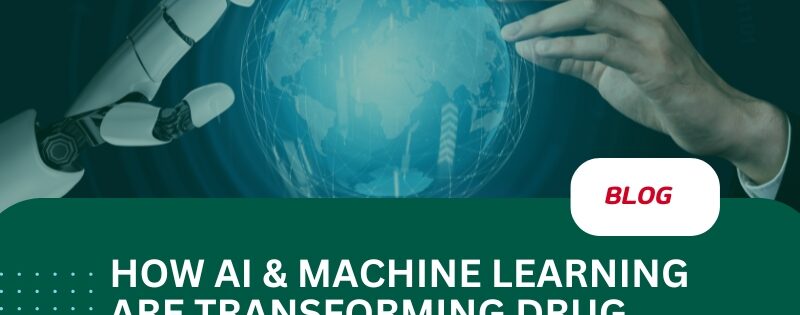Introduction: Drug discovery has traditionally been a lengthy, costly and uncertain journey but the rise of Artificial Intelligence (AI) and Machine Learning (ML) is allowing us to rewrite that narrative. The technology is helping scientists analyse vast biological datasets, identify potential targets and even predict how new compounds might behave all in small period of the time.
The Traditional Challenges in Drug Discovery: Discovery of drug isn’t just slow its also full of risks. The researchers start from studying how a disease works and then try to find a chemical compound that can help treat it but out of thousands of tested compounds only a few shows some results. Even fewer make it through all the steps – lab testing, animal studies and clinical trials on humans. Its like finding a needle in a haystack.
This process often takes over a decade and can estimated cost more than $2.6 billion for just one approved drug. On top of that about 90% of drugs fail during development either because they don’t work well or they cause side effects. These failures are not only disappointing but they are also extremely costly. That’s why researchers and pharma companies are turning to Al and Machine learning hoping to make drug discovery faster, cheaper and more successful.
Role of AI & Machine Learning in Drug Discovery: Artificial Intelligence (AI) and Machine Learning (ML) are changing the way scientists discover the new drugs. Traditionally, researchers had to go through years of trial and errors, testing thousands of chemical compounds to find just one that might work but now AI and ML can do that work much faster and often more accurately.
These technologies help in many stages of drug discovery for example, Al can quickly analyse huge amounts of biological data like genetics information, disease patterns or drug reactions that take humans months or even years to study. This helps scientists identify which parts of the body to target for the treatment called as target identification.
Machine learning models can also predict how different molecules might behave in the human body saving a lot of time in early testing. They can flag possible side effects, toxicity or interactions before a drug even reached clinical trials this not only reduces failure rates but also helps design better and much safer medicines at very start.
An exciting role of drug repurposing where Al finds new uses for existing drugs. This was especially useful during the COVID-19 pandemic when researchers used AI tools to search for treatments among already approved medicines. Overall Artificial Intelligence and Machine Learning act like intelligent assistants helping scientists make faster, smart decisions, reduces cost and bring life-saving treatments to patients much sooner than ever before.
Benefits of AL & ML in Drug Discovery: Artificial Intelligence is programmed to take up serval functions which is only limited by nature and the restrictions of its programming. In the pharma industry the basics of the drug manufacturing dictate that the firm must produce drugs in high qualities to be profitable and regain development costs but this require efficiency and scalability at every step of the manufacturing process. Incorporating AI and Machine Learning in pharmaceutical manufacturing can address most of these issues.
Artificial Intelligence and Machine Learning can bring efficiency to every step of the process starting from research and development to manufacturing and distribution. It can cur shortages by forecasting demand using predictive Al. With help of AI it is even possible to optimise supply chains with real-time visibility of shipment location, speed and movement which can be matched with traffic and weather condition data to predict the right route and an accurate ETA for warehouses.
Machine Learning is helping scientists discover new medicines faster and more easily. It can quickly study large amounts of data and suggest which drug ideas might work best this saves a lot of time and money by avoiding too many failed tests. It also helps in designing better medicines, finding new uses for old drugs and creating treatments that are more suited to each person.
Challenges & Limitations in Drug Discovery: Drug discovery is a long and difficult process with many challenges. Many drug candidates fail during testing because they don’t work well or have harmful side effects. There are also issues like limited understanding of some diseases, difficulty in predicting how a drug will behave in the human body and strict regulations. All these factors make drug discovery slow and risky
Future Outlook: The future of drug discovery looks promising, especially with the help of advanced technologies like AI and machine learning. These tools are making it easier to find new medicines faster, more accurately, and at a lower cost. In the coming years, we can expect drug development to become more personalized, using data from patients to create treatments that are tailored to their needs.
Conclusion:
AI and Machine Learning are changing the way we discover new medicines. What once took years of hard work, huge costs, and many failures is now becoming faster, smarter, and more efficient. These technologies are helping scientists understand diseases better, test drug ideas more quickly, and create safer treatments. While there are still challenges to face, the future of drug discovery looks bright. With continued innovation and teamwork between science and technology, we’re moving closer to a world where life-saving medicines can reach people faster than ever before.
Stay informed and empowered—explore more at www.alperohealthcare.com




